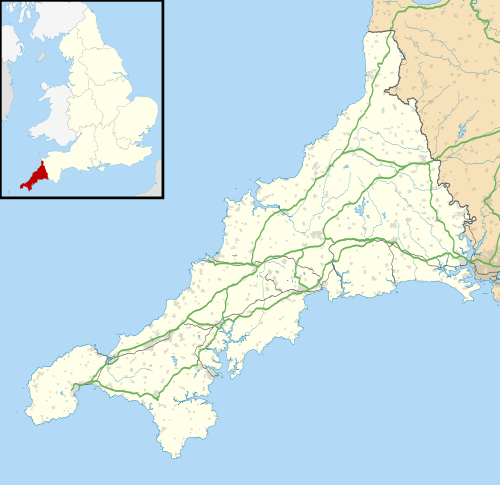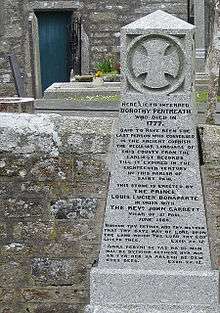Paul, Cornwall
Paul (Cornish: Breweni)[1] is a village in Cornwall, England, United Kingdom. It is in the civil parish of Penzance. The village is two miles (3 km) south of Penzance and one mile (1.6 km) south of Newlyn.[2]
Paul
| |
|---|---|
 Paul parish church | |
 Paul Location within Cornwall | |
| Population | 269 (2011 Census including Buryas Bridge and Castallack) |
| OS grid reference | SW462269 |
| Civil parish | |
| Unitary authority | |
| Ceremonial county | |
| Region | |
| Country | England |
| Sovereign state | United Kingdom |
| Post town | PENZANCE |
| Postcode district | TR19 |
| Dialling code | 01736 |
| Police | Devon and Cornwall |
| Fire | Cornwall |
| Ambulance | South Western |
| UK Parliament | |
The village of Paul should not be confused with the civil parish of Paul, which lies west of the village and, since 1934 with the reorganisation of local government, does not include the village of Paul.
Like many Cornish communities Paul has its own community celebration. Paul Feast is held on the Sunday nearest 10 October every year when the village is decorated and a civic service takes place on the Sunday of the feast itself led by the Mayor of Penzance.
History
Much of the history of Paul is connected with its parish church. The church itself is said to have been founded in 490, a very uncertain date and not documented, by Paul Aurelian, a Welsh saint known in Brittany as Paol Aurelian in Breton. There is no historical evidence to support his ever coming to West Penwith. He was founder of the cathedral at Saint-Pol-de-Léon, the city named after him. However this church could have been dedicated to Paul the Apostle, or Paulinus of York, there is no documentary evidence to prove any of these three Saint Pauls was the original dedicatee of the church. It was only named 'St. Pol-de-Leon' in 1907 and is probably connected with Henry Jenner who (with W. C. Borlase) opposed alleged 'Englishness' and consistent spelling of Cornish place names on OS maps.
The first documented name for Paul Church comes from the registers of Bishop Bronescombe, when on 2 May 1259 the first recorded priest was installed, as Rector in his own right, in the 'Ecclesie Sancti Paulini'--Church of Saint Paulinus (but either Paulinus of York or Paulinus of Wales could have been intended).
Paul village, original name 'Brewinney' and its church have a long association with Mousehole and the church has served as this community's parish church since its inception. Paul was one of the communities along with Mousehole, Newlyn, and Penzance to be destroyed in the Spanish raid of 1595 carried out by Carlos de Amésquita.[3]
Captain Stephen Hutchens (died 1709, Port Royal, Jamaica) bequeathed £500 to the building of almshouses and the maintenance of six poor men and six poor women born in the parish. At the beginning of the 19th century it was found that the almshouses, instead of being administered as bequeathed, were being used as a workhouse for all the poor of the parish. Consequently, a new poor house was built on Trungle Moor.[4]
Cornish language (memorials)

Within the village churchyard there is a memorial to Dolly Pentreath, reputedly and disputedly the last native speaker of Cornish. This memorial was placed there by Louis Lucien Bonaparte, a relative of Napoleon Bonaparte, and the Vicar of Paul in the 19th century.
The Cornish language writers Nicholas Boson, Thomas Boson and John Boson are all buried in Paul Churchyard, and a monument in the church by John Boson (to Arthur Hutchens, d. 1709) is the only surviving lapidary inscription in traditional Cornish.[5]
Parish
The ancient parish of Paul (Cornish: Pluw Bowl)[1] included Newlyn and Mousehole as well as the village of Paul. In 1851 Newlyn was separated to form the new ecclesiastical parish of Newlyn St Peter.[6] The ancient parish became a civil parish in 1866, and in 1894 became the Paul Urban District. The urban district was abolished in 1934. Newlyn and the villages of Paul and Mousehole were transferred from the civil parish and urban district of Paul to the municipal borough of Penzance,[7] now the civil parish of Penzance. The western part of the civil parish of Paul remained a separate, smaller parish (which did not include the village of Paul), from 1934 to 1974 in West Penwith Rural District.[8]
The civil parish of Paul now consists of a number of scattered settlements west of the village at 50.09°N 5.58°W, including Chyenhal, Castallack, Kemyel Crease, Kemyel Drea, Bossava and Kerris. The population of the civil parish (i.e. excluding the village) was 269 in 2011.[9]
Arthur Langdon (1896) recorded the existence of five stone crosses in the parish. One is at Carlankan, one at Halwyn and one at St Paul Down. There are also crosses in the vicarage hedge and on the churchyard wall (the latter has a crude crucifixus figure on one side).[10]
Mining
In 1788, Wheal Mary mined an east-west lode (near Drift) which was in both Paul and Sancreed parishes. It later became known as Garth (or Gath) mine. Following a period of idleness operations resumed under the name of East Wheal Cock and work continued to 1843 when the mine was known as Wheal Darby. Over forty years after the mine closed, a capped shaft at Bologas was reported to have collapsed and the mine was referred to as ″Gath mine″ in The Cornishman newspaper. All signs of the mine on the ground had disappeared by 1925, although quantities of ″wood tin″, continued to find their way into Cornish mineral collections.[11] [12]
In the north of the civil parish is Chyenhal Moor, a Site of Special Scientific Interest noted for its biological interest.[13]
Governance
The village of Paul is represented on Penzance Town Council. For elections to Cornwall Council (the unitary authority) Paul is within the three-member Penzance Electoral division.
Sport
Paul Cricket Club home is at Hutchens Park Playing Field, Trungle Moor and they play in Division Two West; the third tier of the Cornwall Cricket League. In 2007 the club came second in the Cornwall Cricket League and won the competition in 2010, to become Cornish champions for the only time.[14] Adjacent to the cricket club is Mousehole AFC (established 1923). The first team have played in Division One West of the South West Peninsula League since its inauguration in 2007. Their best season was 2013–14 when they came second.
References
- Place-names in the Standard Written Form (SWF) Archived 15 May 2013 at the Wayback Machine : List of place-names agreed by the MAGA Signage Panel Archived 15 May 2013 at the Wayback Machine. Cornish Language Partnership.
- Ordnance Survey: Landranger map sheet 203 Land's End ISBN 978-0-319-23148-7
- West Penwith Resources – The Spanish Attack – 1595
- "Paul". The Cornishman (36). 20 March 1879. p. 4.
- Spriggs, Matthew, 'Boson family (per. c.1675–1730)', Oxford Dictionary of National Biography, Oxford University Press, 2004 accessed 12 Oct 2007
- Genuki website: Paul
- Vision of Britain website
- Vision of Britain website: Paul UD
- Census 2011: Neighbourhood statistics
- Langdon, A. G. (1896) Old Cornish Crosses. Truro: Joseph Pollard; pp. 202-04, 103 & 192-93
- "Garth Mine (Wheal Darby; East Wheal Cock; Gath Mine; Wheal Mary), Sancreed, Cornwall, England, UK". mindat.org. Retrieved 18 August 2020.
- "The Dangers Of A Badly-Filled Shaft". The Cornishman (338). 8 January 1884. p. 4.
- "Chyenhal Moor" (PDF). Natural England. 1985. Retrieved 26 October 2011.
- Cricket in Cornwall 2014. Cornwall Cricket Board. 2014. p. 221.
External links

- GENUKI website; Paul